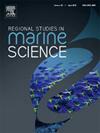摩洛哥水域巨型海洋动物搁浅:物种多样性、时空分布和主要威胁
IF 2.1
4区 环境科学与生态学
Q3 ECOLOGY
引用次数: 0
摘要
我们报告了对摩洛哥水域(大西洋和地中海)海洋巨型动物搁浅的初步研究,该研究为期10年,从2014年到2023年。总共记录了524种海洋巨型动物搁浅,包括9科24种。鲸类和海龟分别占总搁浅个体的85.5 % (n = 448)和14.5 % (n = 76)。在被确定搁浅的24个物种中,有7个物种被国际自然保护联盟列为濒危物种。搁浅事件的数量在2014年至2023年期间显著增加,在2020年至2023年期间增加得更快,这可能是由于摩洛哥水域的人为活动和观测工作不断增加。具体来说,与地中海(10种鲸类和2种海龟)相比,大西洋水域拥有最高的海洋巨型动物分类多样性(17种鲸类和2种海龟)。海豚属德尔福(28.8 n = 151年 %),Stenella coeruleoalba (11.5 n = 60, %),一道acutorostrata (9.9 n = 52岁的 %)和Globicephala米拉(n = 5)是最常被困鲸类物种。海龟中最常见的是Caretta Caretta (n = 52,9.9 %),其次是Dermochelys coriacea (n = 24,4.6 %)。摩洛哥水域全年都观察到搁浅现象,但在夏季(6 - 8月,n = 153,29.2 %)达到高峰。大多数搁浅与人为的相互作用有关。其中,副渔获物是257起搁浅事件的主要因素。我们的研究结果有助于更好地了解摩洛哥海岸的海洋巨型动物群落,这对改善海龟和鲸类的研究、管理和保护至关重要。本文章由计算机程序翻译,如有差异,请以英文原文为准。
Stranding of marine megafauna in Moroccan waters: Species diversity, spatio-temporal distribution and main threats
We report the initial study on marine megafauna strandings in Moroccan waters (Atlantic and Mediterranean), conducted over a 10 year of study period from 2014 to 2023. Altogether, 524 marine megafauna strandings were documented, encompassing 9 families and 24 species. Cetaceans and sea turtles constitute 85.5 % (n = 448) and 14.5 % (n = 76) of the total stranded individuals, respectively. Of the 24 species identified stranded, seven species were classified as Endangered by the IUCN. The number of strandings events raised significantly between 2014 and 2023 and more rapidly between 2020 and 2023, which is probably due to growing anthropogenic activities and observation efforts in Moroccan waters. Specifically, Atlantic waters host the highest taxonomic diversity of marine megafauna (17 species of cetaceans and 2 species of sea turtles) compared to the Mediterranean (10 species of cetaceans and 2 species of sea turtles). Delphinus delphis (n = 151, 28.8 %), Stenella coeruleoalba (n = 60, 11.5 %), Balaenoptera acutorostrata (n = 52, 9.9 %) and Globicephala melas (n = 5) were the most frequently stranded cetacean species. For sea turtles, the most frequently recorded species was Caretta caretta (n = 52, 9.9 %) followed by Dermochelys coriacea (n = 24, 4.6 %). Strandings were observed throughout the year in Moroccan waters, but peaked in summer (June-August, n = 153, 29.2 %). The majority of stranding were associated to anthropogenic interactions. Among these instances, the bycatch was the primary factor in 257 occurrences of stranding. Our results contributed to a better understanding of marine megafauna communities in both Moroccan coasts, which are essential for improving research, management and conservation of marine turtles and cetaceans.
求助全文
通过发布文献求助,成功后即可免费获取论文全文。
去求助
来源期刊

Regional Studies in Marine Science
Agricultural and Biological Sciences-Ecology, Evolution, Behavior and Systematics
CiteScore
3.90
自引率
4.80%
发文量
336
审稿时长
69 days
期刊介绍:
REGIONAL STUDIES IN MARINE SCIENCE will publish scientifically sound papers on regional aspects of maritime and marine resources in estuaries, coastal zones, continental shelf, the seas and oceans.
 求助内容:
求助内容: 应助结果提醒方式:
应助结果提醒方式:


